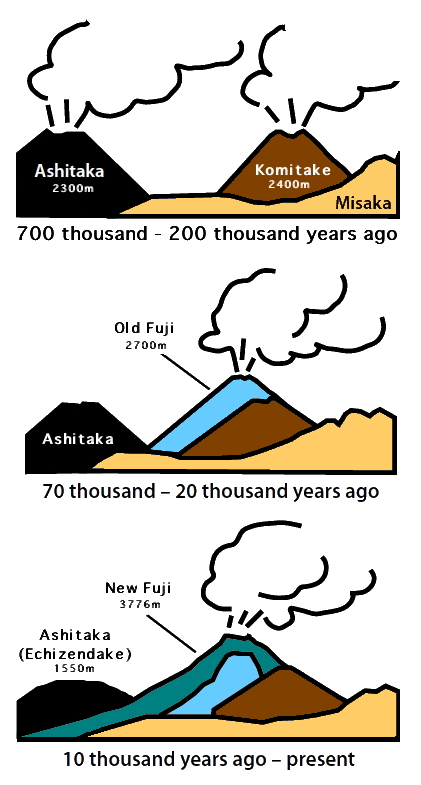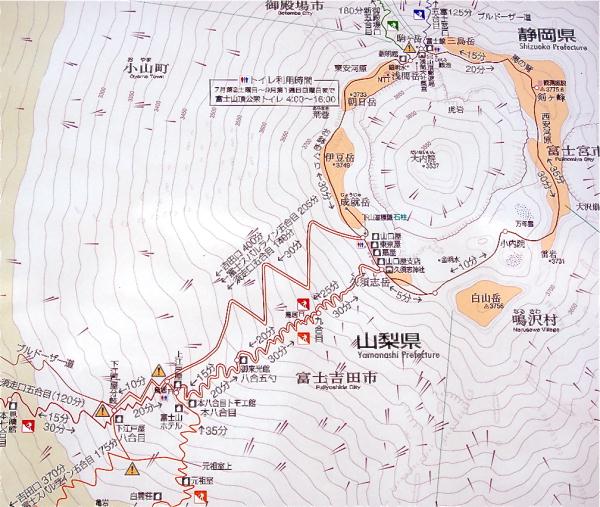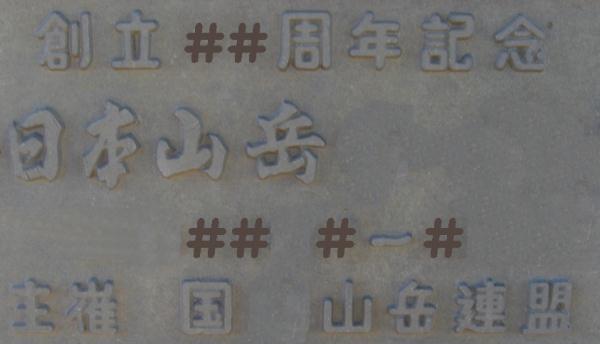Introduction

Climbing Mt. Fuji, the highest mountain in Japan (12,388 ft / 3776 m) is an exciting and exhilarating experience that requires little expertise and equipment. However, lack of preparation and disregard for simple, yet critical safety precautions can result in serious injury or death. Although it is not easy and should be approached as a legitimate physical and mental challenge, anyone in good physical condition can climb Mt. Fuji. The official climbing season for Mt. Fuji is from 1 July to 26 August. This Earthcache attempts to provide useful information for Geocachers interested in climbing Mount Fuji, while at the same time provide educational awareness beyond the challenge of the climb.
Fuji Historical Geology
Komitake Volcano that now forms the northern part of Mt. Fuji first erupted 700 thousand years ago, emitting sticky lava and lapilli for a long time. At the same time, the southern part Mt. Ashitaka was erupting. Mt. Komitake was about 2,400 m high. The older Fuji Volcano erupted again on the south of Komitake Volcano, sending out brass-colored volcanic mud flows in all directions. It is considered to have become a large strato-volcano, the height of which attained about 2,700m. The eruption on younger Fuji Volcano broke out on the nearest region to the center of the older Fuji Volcano about 10 thousand years ago. The younger Fuji Volcano emitted less sticky lava, volcanic ash, sand and lapilli continuously. It buried Komitake Volcano and older Fuji Volcano, adding to its height and finished the organic movement several thousand years ago.
Mt. Fuji…
… is the second highest single mountain in the world.
… is as high as about 8.5 Empire State Buildings.
… is 9455 km from GC18FHR Zugspitze Earthcache.
… average temp. on the top in mid-summer: about 6°C (43°F).
… trail surface is rock, gravel, sand and volcanic ash.
Safety Tips
> If there are lightning or storms, cease climbing and find shelter.
> Stay on the climbing path, otherwise there is the possibility of encountering rock slides or getting lost.
> When climbing at night, be careful in rocky areas. It is easy to stumble and fall.
> Rock slides are frequent. If you see a rock slide, shout to alert other climbers. Stay to the inside of the path where footing is more firm, and the wall can offer protection.
> Rock slides sound like thunder. Hit the ground immediately closest to the wall if you hear it.
> Do not drink alcoholic beverages and limit your caffeine intake.
> In the event of injury or sickness, perform necessary first aid, then carry the person to the nearest mountain hut and contact a doctor (there is one at the 6th station),
Suggested Supply List
Do not over-pack. Food and drink is available on the mountain, keeping in mind that prices rise with the elevation.

> Thick-soled hiking boots
> Medium size backpack
> Lightweight convertible hiking pants
> Lightweight rain gear
> Change of socks
> Water bottle or hydration system (i.e. Camelback)
> Water (at least 2.0+ liters for average adult)
> Gel type energy drinks
> Light meal (cheese/sandwiches/beef jerky/sweets)
> Sunglasses
> Sunscreen
> Hat (with visor)
> Climbing stick or trekking poles (if possible)
> Headlamp with extra batteries (if climbing at night)
> GPS with extra batteries
> Camera
> Gators
> Warm jacket or fleece
> Long sleeved shirt
> Small towel
> Utility gloves
> Aspirin-Motrin-Tylenol
> Cash (Yen -- see below examples)
> Blister kit with moleskin
> First aid kit (some bandages)
> Plastic bags (to keep your things dry & for trash)
> Small roll of toilet paper
> Oxygen can (if possible)
> Wet tissue/wipes
> Cotton surgical mask or bandana (trail dust on the way down)
> Watch & cell phone (to tell time and for emergency)
> Lightweight iPod or MP3 player & headphones
Example Expenses
> Climbing Stick (Kongou-zue): ¥1000-¥1200
> Climbing stick stamps: ¥200 (13+ stations)
> Bathroom Charge: ¥200 each
Climbing
The average climbing time is 6–7 hours from 5th station to the top. Set a slow and steady pace from the beginning and avoid overexertion. Take frequent short breaks. To prevent dehydration, drink plenty of fluids. Rest properly -- it is recommended that you have at least 8 hours of sleep prior to the climb. Without sufficient rest, injuries and exhaustion can result.
Overexertion
Altitude sickness (nausea, chest aches, and dizziness) often occurs when climbers rush whil e on the lower, less steep areas of the mountain. The result is improper adjustment to higher elevations, oxygen depletion, and muscle cramps, etc. A key to a successful climb is to appreciate the mountain. The difficult parts are from stations 8 to summit, so conserve energy whenever possible. Take your time, as frequent short breaks are better than longer breaks. Keep steps short, and keep your weight centered over your legs. Reaching the summit is “mind over body”. If you are not serious about the climb or you approach the task lightly, you will probably end up turning back. If the desire is low, stay home.
e on the lower, less steep areas of the mountain. The result is improper adjustment to higher elevations, oxygen depletion, and muscle cramps, etc. A key to a successful climb is to appreciate the mountain. The difficult parts are from stations 8 to summit, so conserve energy whenever possible. Take your time, as frequent short breaks are better than longer breaks. Keep steps short, and keep your weight centered over your legs. Reaching the summit is “mind over body”. If you are not serious about the climb or you approach the task lightly, you will probably end up turning back. If the desire is low, stay home.
Hypoxia
The first problem with climbing Mt. Fuji is hypoxia. Hypoxia occurs when the cells in your body don’t get enough oxygen. 21% of the atmosphere surrounding you is oxygen. That is more than enough to keep your body happy at sea level. At the summit of Mt. Fuji you are still surrounded by 21% oxygen. People have problems because at the summit there is less atmospheric pressure surrounding you. 21% of what is left is still oxygen but it is not enough to keep your body happy.
What to do at the summit?
> Watch the sunrise (for overnight climbers) above the “Sea of clouds.”
> Get a stamp on your climbing stick.
> Walk around the summit crater on an hour-long circuit.
> Mail a letter from the summit post office. Open 6 am – 2 pm, 10 Jul–20 Aug.
Descending
Keep in mind that many say going down is harder than up. It will take on average four hours to descend. It can be dry and dusty on the way down. Make sure to have plenty of water for the way down as there are no huts selling provisions—get it at the top before you descend.
To Claim Credit
1. At the listed coordinates, find the brass plaque. Using the six (6) numbers (#) on the plaque (reading from left to right, top to bottom), send an e-mail to ######@gmail.com. Please type Mount Fuji Summit Earthcache in the subject line. If you have answered correctly, you will receive an answer right away.
2. Post in your log the following information:
a. How long it took you to reach the summit.
b. The altitude reading for your GPS at the GZ.
c. The weather observed weather conditions at the GZ: time, cloud cover (% of sky obscured), general condition (i.e. rain, sun, foggy).
d. The description of results for the exercise in number 3 below.
3. This exercise will demonstrate what happens to the Earth's atmospheric pressure as altitude changes; it requires you bring along a standard party balloon. At some point before starting your climb, blow the balloon up to the size of a softball, somewhat less than 50% capacity. Tie it to your pack. As you climb, note what happens to the balloon. This can also be done in reverse.
4. Post a photo of yourself, your GPS, balloon or some wonderful view (optional).
Please do not post any photos of the plaque or structure to which the plaque is attached as those posts will be deleted. If you do not reach the plaque and send me the required numbers, please do not claim the find.
References
Physical Geology 2003, Mt. Fuji, Emily L. Steele, April 08, 2003, http://www.earlham.edu/~steelem/mtfuji.htm
Mt. Fuji Mountaineering Guide, Outdoor Recreation, Yokota AB
Congratulations to Finndus_98 for FTF!
